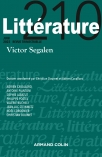
Romantisme N°200 (2/2023)
Pour acheter ce numéro, contactez-nous
Recevez les numéros de l'année en cours et accédez à l'intégralité des articles en ligne.
Au XIXe siècle, la chanson est une réalité fluctuante, dans ses fonctions, sa constitution ou sa poétique. La possibilité d’enregistrement après 1877 amorce un changement des paradigmes : la captation sonore s’impose en tant que performance. Les enregistrements de chansons se multiplient à partir des années 1890, grâce à des inventeurs comme Charles Pathé et surtout Henri Lioret, avec ses cylindres en celluloïd. Le corpus de plus de 200 enregistrements réalisés par Lioret entre 1893 et 1895, accessibles sur le site Phonobase, permet de faire ressortir plusieursmarqueurs d’une nouvelle esthétique, issue de celle des cafés-concerts, mais s’en écartant néanmoins parfois : éclectisme des styles, prédominance de l’a capella – qui souligne a contrario la présence d’instruments –, effets de théâtralisation à plusieurs voix et commentaires, et surtout, anonymisation des interprètes. Y répondront, mais à partir de 1897, des enregistrements de vedettes identifiées : à la pure gloire scénique succèdera le vedettariat phonographique.
In the 19th century song is a fluctuating reality, in its functions, its structures and its poetics. Recording as a possibility after 1877 initiates a change in paradigm: sound recording becomes a form of performance. Song recordings multiply starting in the 1890s, thanks to inventors such as Charles Pathé or especially Henri Lioret, with his celluloïd cylinders. The corpus for this paper of more than 200 recordings made by Lioret between 1893 and 1895, accessible on the Phonobase site, enables bringing to light a certain number of signs indicating a new aesthetic, originating in cafe concerts but not quite identical to these: eclecticism in style, domination of a capella — which a contrario highlights the presence of instruments if any — theatrical effects using several voices and commentary and, most especially, anonymity of the performers. In response there will be, but only starting in 1897, recordings of stars with their names indicated: after pure scenic glory, will come phonographic stardom.

